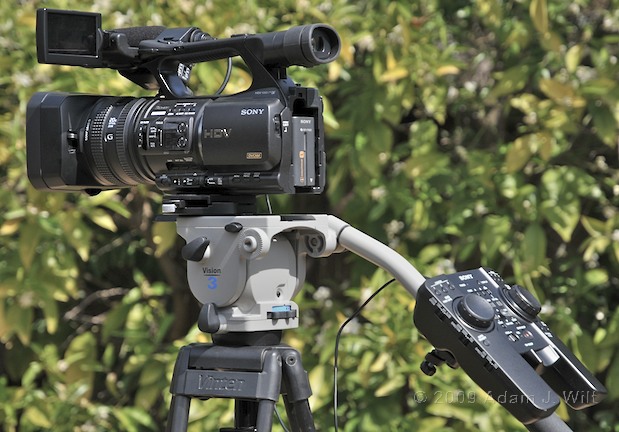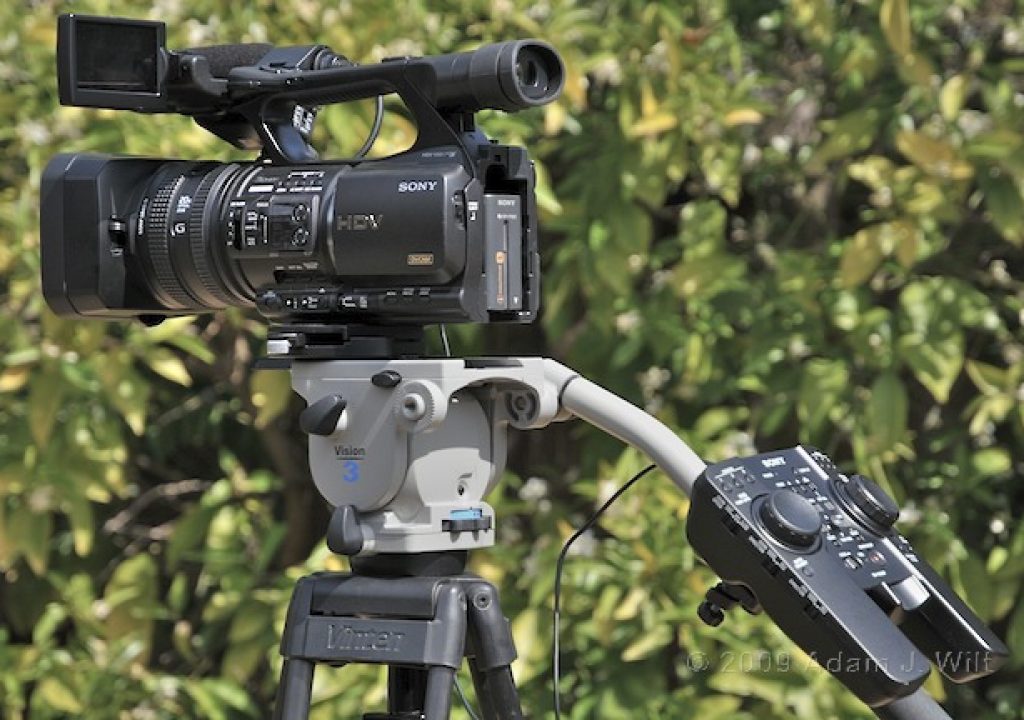
The RM-1000BP controlling an HVR-Z5U.
Sony’s US$1200 (street price) RM-1000BP Remote Commander is a LANC remote control. It connects to any Sony camcorder with a 2.5mm LANC (a.k.a. Control-L) jack, which means most consumer/prosumer Sonys built in the past two decades.
On most of those camcorders, it’ll do pretty much what any other LANC controller does: start and stop recording, zoom the lens in and out, and (maybe) change focus or white balance. But on the latest generation DV camcorders—the HVR-Z5U, HVR-Z7U, and HVR-S270U—it gives you full access to just about every button and control on the camera, including menus and picture presets.
Physical Description
The RM-1000BP in its carrying case, with 10 meter cable and wrist strap.
The RM-1000BP comes in a handsome padded case, with a wrist strap for handheld use and a clamp for fixing the unit to a tripod or jib arm handle. Two detachable LANC cords come with it, a 1 meter (3.3 foot) and a 10 meter (33 feet!) cable. Both have bayonet-locking collars on the controller end so they’ll stay connected, while the camera ends terminate in a standard, right-angle 2.5mm three-conductor plug.
The RM-1000BP has rotary focus and iris knobs, a zoom rocker, a menu joystick, and plenty of buttons.
The RM-1000BP is about six inches wide and seven inches tall, including the two protruding handgrips that remind me of a games controller. The unit can be handheld, placed on a table (it has four rubber feet), mounted on a tripod or support arm using a 1/4×20 threaded socket on the back, or clamped to a tripod handle using the supplied clamp.
Rotary knobs for focus and iris provide full proportional control. Pushing a knob in triggers momentary autofocus or auto-iris actions which lock when you let the knob up. Pushbuttons beside the knobs toggle focus and iris between manual and full-auto operation.
A zoom rocker centered below the panel offers precise control of the zoom lens. Its curved upper surface and 90 degrees of rotation give you direct, predictable control over the zoom speed whether using one or two thumbs to operate it.
Dedicated buttons let you choose auto or manual selection of shutter, gain, and white balance, let you choose and set your WB presets, declutter the camera’s data displays, and engage expanded focus. Six assignable buttons echo their functions on the connected camera. Menu and Picture Profile buttons call up their associated menus, which you can navigate with a four-way joystick.
A programmable Hold switch lets you lock out your choice of operations. LEDs show when power is applied and when recording is in progress. A big fat Record button starts and stops the camcorder.
Side switches let you pick control directions and speeds (there’s one for focus on the far side).
Slide switches on the sides of the controller let you reverse the sense of the focus, iris, and zoom controls (e.g., clockwise to open the iris, or clockwise to close the iris, whichever seems more natural to you). A Zoom Speed switch lets you choose a single, slow zoom speed, four speed levels, or eight speed levels. The latter setting makes the zoom rocker feel as sensitive and precise as the rocker on the camera itself.
Performance
When I hooked the RM-1000BP to an HVR-Z5U, there wasn’t anything I couldn’t make the camera do in camera mode. True, my slowest zoom with the controller was 35 seconds, whereas I could go as slowly as 60 seconds with the camera’s own zoom rocker, but aside from that, the controller gave me direct access to every camcorder-mode function of the Z5U that the camera itself did. Zooms, focus pulls, and iris changes could be performed quickly or slowly as I saw fit. When the lens was set for AF ASSIST mode, I could turn the focus knob to fine-tune the focus even as the camera focused itself. I could get into all the menus and picture profile settings just using the controller, and I preferred to: the controller’s large, flat buttons and the excellent joystick were much easier and faster to use than the Z5U’s recessed buttons and fiddly little thumbwheel.
True, there are some limitations. Due to the nature of the LANC protocol, you can’t do two things at once (such as zoom and focus simultaneously). If you try, one control or the other will win, usually the one you started fiddling with first. If you stop messing about with the winning control but continue to frob the other knob, the camera will start to respond to the second control a short time after it stops receiving commands from the first.
The RM-1000BP is focused on recording, not playback: there aren’t any transport controls other than the start/stop button. While this seems like an unfortunate omission—many older, lesser LANC remotes had a full set of transport keys—the fact is that most Sony camcorders need direct hands-on actions to reboot them into VTR or playback mode, so the value of having transport controls on a remote controller isn’t as great as it might seem.
Also, the RM-1000BP lacks any feedback other than the two LEDs; the expectation is that you’ll have a video feed from the camera for monitoring purposes, and modern Sonys have some of the best onscreen data displays around. Still, some older LANC remotes had an LCD showing transport status and timecode (or tape counter numbers), and it can be useful to have those readouts directly available on the control panel itself.
Finally, using the remote with older cameras will only provide a subset of functions offered. LANC has evolved over the years, and while it’s largely backwards-compatible, many of the modern nuances of the language aren’t well understood by cameras from a simpler time.
I plugged the RM-1000BP into my ancient, 1995 DCR-VX1000, one of the first DV camcorders. I was able to start and stop the transport, zoom (even proportionally, which was a nice surprise), toggle the white balance settings and store a new white balance preset, and navigate the menus: very handy on the VX1000, as the camera’s menu button is behind the rear panel / battery door. But the camera ignored the remote’s focus, iris, and gain commands, and it obviously didn’t know what to make of the assignable buttons, expanded focus, or the picture profile button, all of which postdate this camera’s creation.
Conclusion
The RM-1000BP Remote Commander might seem expensive for a LANC controller, but with a modern HDV camcorder it gives you total control over that camera. If you need to put an HVR-Z5U, Z7U, or S270U on a jib arm, in an out-of-the-way location, or in any other situation where it’s inconvenient or impossible to lay hands directly on the camera’s controls, you can now do so without giving up any real ability to set up or run that camcorder. This remote allows those camcorders to be used in ways they simply weren’t practical for before, and thereby opens up new creative and operational possibilities.
Prior to this, the only way to gain comparable control over an affordable camcorder was to get Canon’s $500 Console software to talk to their high-end HDV camcorders (and have a Windows XP SP2 PC to run it on, of course), or use an PMW-EX3 with the $2000 RM-B150 or the $4500 RM-B750 remote operations panels. Suddenly, $1200 doesn’t seem so expensive, after all…
If you have an older camcorder, the value of the RM-1000BP will likely be proportional to the degree of control it provides you—and that will depend on how well your camera and this controller communicate with each other. But given how well it talked to my venerable VX1000, I’d say that more modern cameras will likely work well with it.
If a remote control is something you need, and you have a Sony with a LANC port, take a look. If that Sony happens to be a Z5U, Z7U, or S270U, just buy the danged thing: Red Bull gives you wings, but the RM-1000BP gives you ten-meter-long arms.
Pros
- Remote access to every function and control of an HVR-Z5U, Z7U, or S270U.
- Fully proportional, variable speed control over focus, iris, and zoom.
- Reversible control directions; customizable hold function.
- Provides faster, easier operations than many of the camera’s own controls do.
- One- and ten-meter LANC cables.
- Good ergonomics for handheld, tabletop, or tripod-mounted uses.
Cons
- LANC limits you to one thing at a time; no simultaneous zooming and focusing.
Cautions
- Functionality with older camcorders depends on the command set implemented by the camcorder itself; not all the RM-1000Bps controls may be available on cameras other than the HVR-Z5, Z7, and S720
- No playback controls.
- The RM-1000BP will not make you coffee and pancakes. It’s versatile, but not that versatile.

